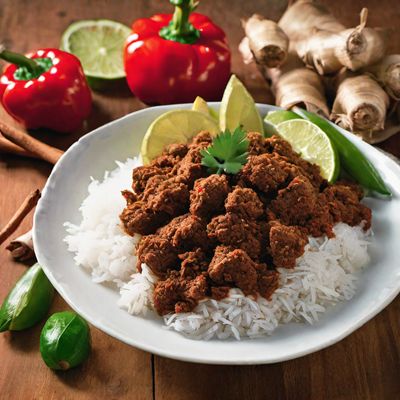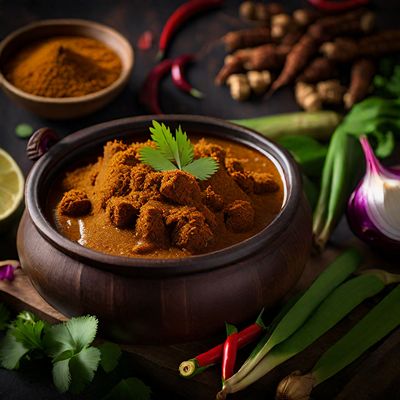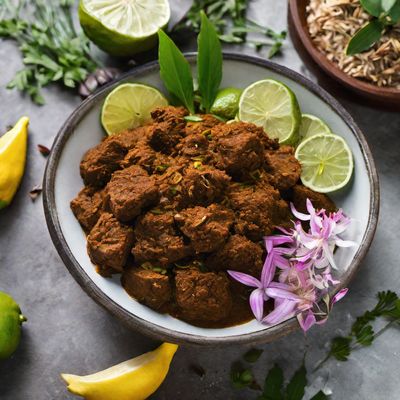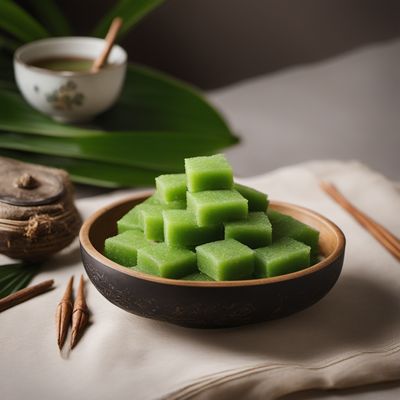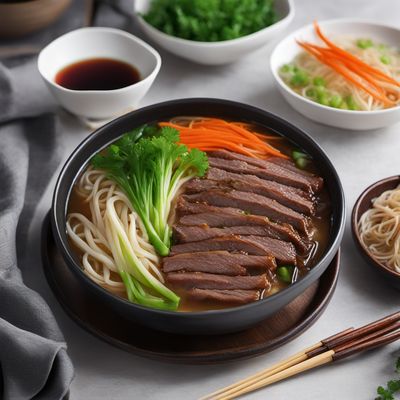
Recipe
Japanese-style Rendang
Umami-infused Beef Stew with Japanese Flavors
4.8 out of 5
In the context of Japanese cuisine, this Japanese-style Rendang is a delightful fusion of Indonesian and Japanese flavors. This slow-cooked beef stew is rich, tender, and packed with umami. The combination of traditional Indonesian spices and Japanese ingredients creates a unique and delicious dish that will satisfy your taste buds.
Metadata
Preparation time
20 minutes
Cooking time
2 hours
Total time
2 hours and 20 minutes
Yields
4 servings
Preparation difficulty
Medium
Suitable for
Omnivore, Gluten-free, Dairy-free, Nut-free, Low carb
Allergens
Soy
Not suitable for
Vegan, Vegetarian, Paleo, Keto, Halal
Ingredients
While the original Indonesian Rendang is known for its bold and spicy flavors, this Japanese-style adaptation incorporates milder and more delicate flavors. The use of Japanese ingredients such as soy sauce, mirin, and sake adds a subtle sweetness and umami to the dish. Additionally, the cooking time is slightly reduced to achieve a tender texture while maintaining the essence of Rendang. We alse have the original recipe for Rendang, so you can check it out.
-
500g (1.1 lb) beef, thinly sliced 500g (1.1 lb) beef, thinly sliced
-
2 tablespoons vegetable oil 2 tablespoons vegetable oil
-
1 onion, thinly sliced 1 onion, thinly sliced
-
3 cloves garlic, minced 3 cloves garlic, minced
-
1 thumb-sized ginger, grated 1 thumb-sized ginger, grated
-
2 tablespoons soy sauce 2 tablespoons soy sauce
-
2 tablespoons mirin 2 tablespoons mirin
-
2 tablespoons sake 2 tablespoons sake
-
2 tablespoons brown sugar 2 tablespoons brown sugar
-
1 tablespoon miso paste 1 tablespoon miso paste
-
1 tablespoon tomato paste 1 tablespoon tomato paste
-
1 cinnamon stick 1 cinnamon stick
-
2 star anise 2 star anise
-
3 cardamom pods 3 cardamom pods
-
1 lemongrass stalk, bruised 1 lemongrass stalk, bruised
-
400ml (1 2/3 cups) coconut milk 400ml (1 2/3 cups) coconut milk
-
Salt, to taste Salt, to taste
Nutrition
- Calories (kcal / KJ): 450 kcal / 1884 KJ
- Fat (total, saturated): 30g, 20g
- Carbohydrates (total, sugars): 10g, 5g
- Protein: 35g
- Fiber: 2g
- Salt: 1.5g
Preparation
-
1.Heat the vegetable oil in a large pot over medium heat.
-
2.Add the sliced onion, minced garlic, and grated ginger. Sauté until fragrant and the onion becomes translucent.
-
3.Add the beef slices and cook until browned on all sides.
-
4.In a small bowl, mix together soy sauce, mirin, sake, brown sugar, miso paste, and tomato paste. Pour this mixture into the pot and stir well.
-
5.Add the cinnamon stick, star anise, cardamom pods, and bruised lemongrass stalk to the pot.
-
6.Pour in the coconut milk and bring the mixture to a simmer.
-
7.Reduce the heat to low, cover the pot, and let it simmer for 1.5 to 2 hours, or until the beef is tender and the flavors have melded together.
-
8.Season with salt to taste.
-
9.Serve the Japanese-style Rendang hot with steamed rice.
Treat your ingredients with care...
- Beef — Choose a tender cut of beef, such as sirloin or chuck, and slice it thinly against the grain for maximum tenderness.
- Lemongrass — Bruise the lemongrass stalk by lightly pounding it with the back of a knife to release its aromatic oils.
- Miso paste — Look for a mild white or yellow miso paste, as it adds a subtle umami flavor to the dish.
Tips & Tricks
- For a spicier version, add a small amount of Japanese chili powder (shichimi togarashi) or chili flakes.
- If you prefer a thicker sauce, simmer the dish uncovered for the last 30 minutes to allow the liquid to reduce.
- Leftovers can be stored in the refrigerator for up to 3 days and taste even better the next day as the flavors continue to develop.
Serving advice
Serve the Japanese-style Rendang with steamed rice and garnish with sliced green onions or cilantro for a fresh touch. The tender beef and flavorful sauce pair perfectly with the fluffy rice.
Presentation advice
To enhance the presentation, place a small bowl of pickled vegetables or Japanese-style pickles on the side. The vibrant colors and tangy flavors of the pickles will complement the rich and savory Rendang.
More recipes...
For Rendang » Browse all
For Indonesian cuisine » Browse all
More Indonesian cuisine dishes » Browse all

Rijsttafel
Rice Table
Rijsttafel is a Dutch-Indonesian dish that translates to "rice table" in English. It is a large meal that consists of many small dishes served with rice.

Kue putu
Putu Cake
Kue putu is a traditional Indonesian snack that is made with rice flour and coconut. It is a sweet and fragrant snack that is perfect for afternoon tea.
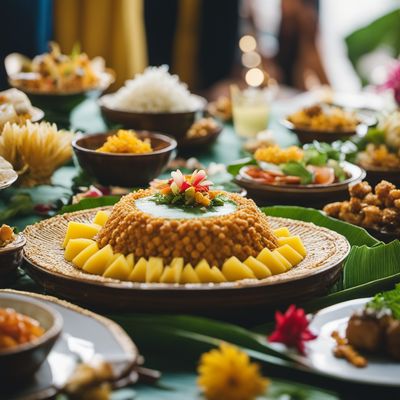
Tumpeng
Tumpeng is a traditional Indonesian dish that is usually served during special occasions such as birthdays, weddings, and other celebrations. It...
More Japanese cuisine dishes » Browse all

Goma wakame
Goma Wakame Salad
Goma wakame is a Japanese dish made with seaweed and sesame seeds.
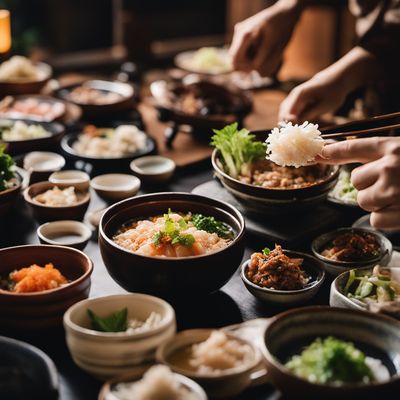
Kamameshi
Kamameshi is a Japanese rice dish that is cooked in a small pot called a kama. It is typically made with rice, vegetables, and meat or seafood.

Kinoko nabe
Mushroom hot pot
Kinoko nabe, or mushroom hot pot, is a traditional Japanese dish that is perfect for cold winter days. It is a hearty soup made with mushrooms and...
